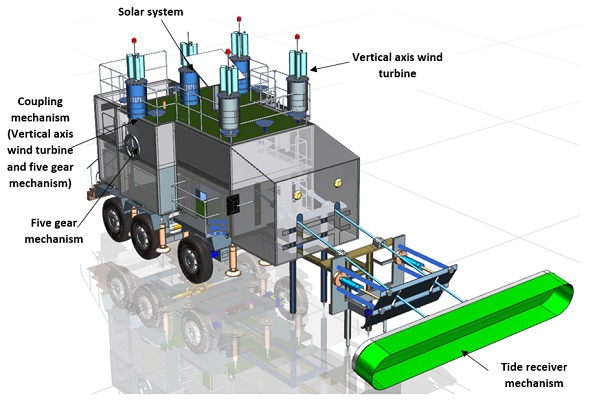
Chennai, October 16 2023: Researchers at the Indian Institute of Technology, Madras, have patented a ‘Combined Power Generation Technology’ technology that can generate electricity from both Tidal and Wind sources. This can be deployed as a mobile vehicle For Power Generation, Transmission and Storage.
The current innovation is an energy converter system that generates electricity in coastal areas to reduce electricity demand. The converter system can be deployed depending on the power requirements in the coastal area. At present, the Researchers are focused on scalability and affordability and are trying to build a cost-effective prototype using 3D-Printing and other technologies.
A wind turbine mounted on a vehicle’s roof will employ the converter technology to generate wind energy as well as convert tidal energy into electrical energy. The energy output of the system or gadget is entirely renewable and sustainable. The roof-mounted solar panel could also be used to power other equipment on mobile vehicles.
This Research was undertaken by Sadham Usean Ramasamy, PhD Research Scholar, Department of Mechanical Engineering, IIT Madras, and Prof. A. Seshadri Sekhar, a former Head, Department of Mechanical Engineering, IIT Madras, who is currently on deputation to IIT Palakkad as its Director.
Elaborating on the key aspects of this innovation, Prof. Sekhar, said, “The current invention creates electricity using only one vertical axis wind turbine, a horizontal converter mechanism, and no hydraulic set generator based on pendulum support. The current converter also has a variety of height adjustable guider support mechanisms to help regulate the height of the elliptical plate attached to the main shaft. The current idea, on the other hand, lacks a horizontal axis turbine and is entirely onshore, therefore there is no severe corrosion problem. Furthermore, the converter is a remote-controlled system that can be relocated to any position based on wave height and power generation requirements. The five gear converters will help operate at least one generator and install at least one vertical axis wind turbine on the roof of a double decker vehicle. The wheel arrangement based on chain teeth/tooth profiles allows the double decker mobile vehicle to be easily relocated from one place to another. Furthermore, without the need for a submarine connection, the generated electricity can be easily delivered from the transformer. Furthermore, the current invention includes individual flywheel topologies for energy storage, which aids in the continuous spinning of the generator shaft and power production. To reduce electricity use, the current innovation is an energy converter system that creates electricity in coastal areas. It also has fewer operating expenses, requires less maintenance, and produces clean energy. It can also be used as a moving vehicle. Tidal energy is a clean, sustainable energy source with significant potential and the unusual capacity to be totally predictable. Depending on the power demand in the coastal area, the converter system may need to be relocated. The converter technology is used by a wind turbine mounted on the vehicle's top to create wind energy as well as convert tidal energy into electrical energy.”